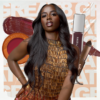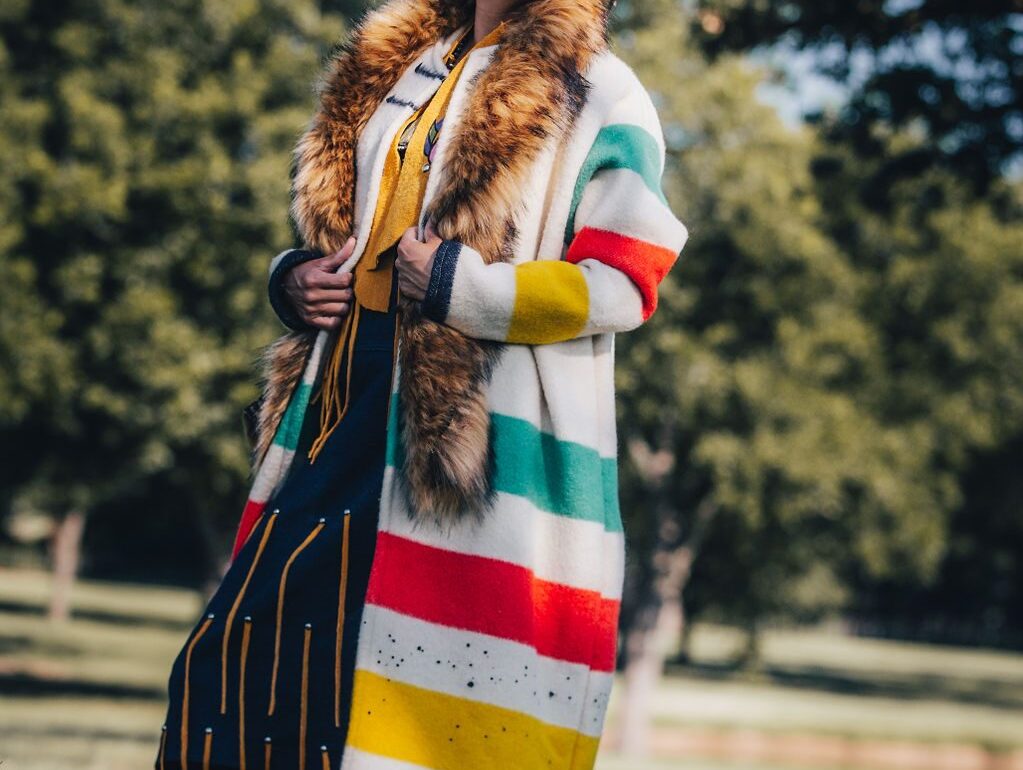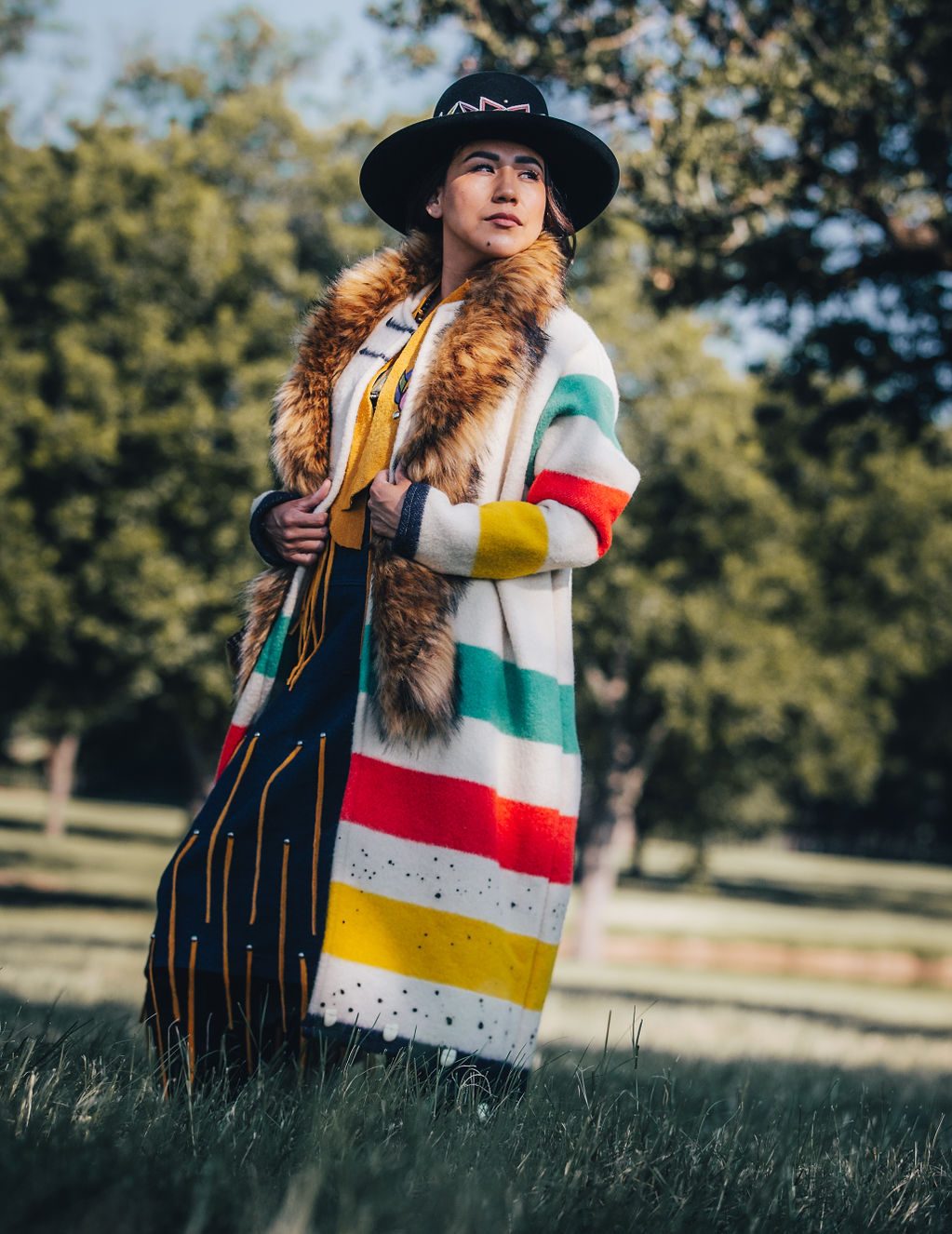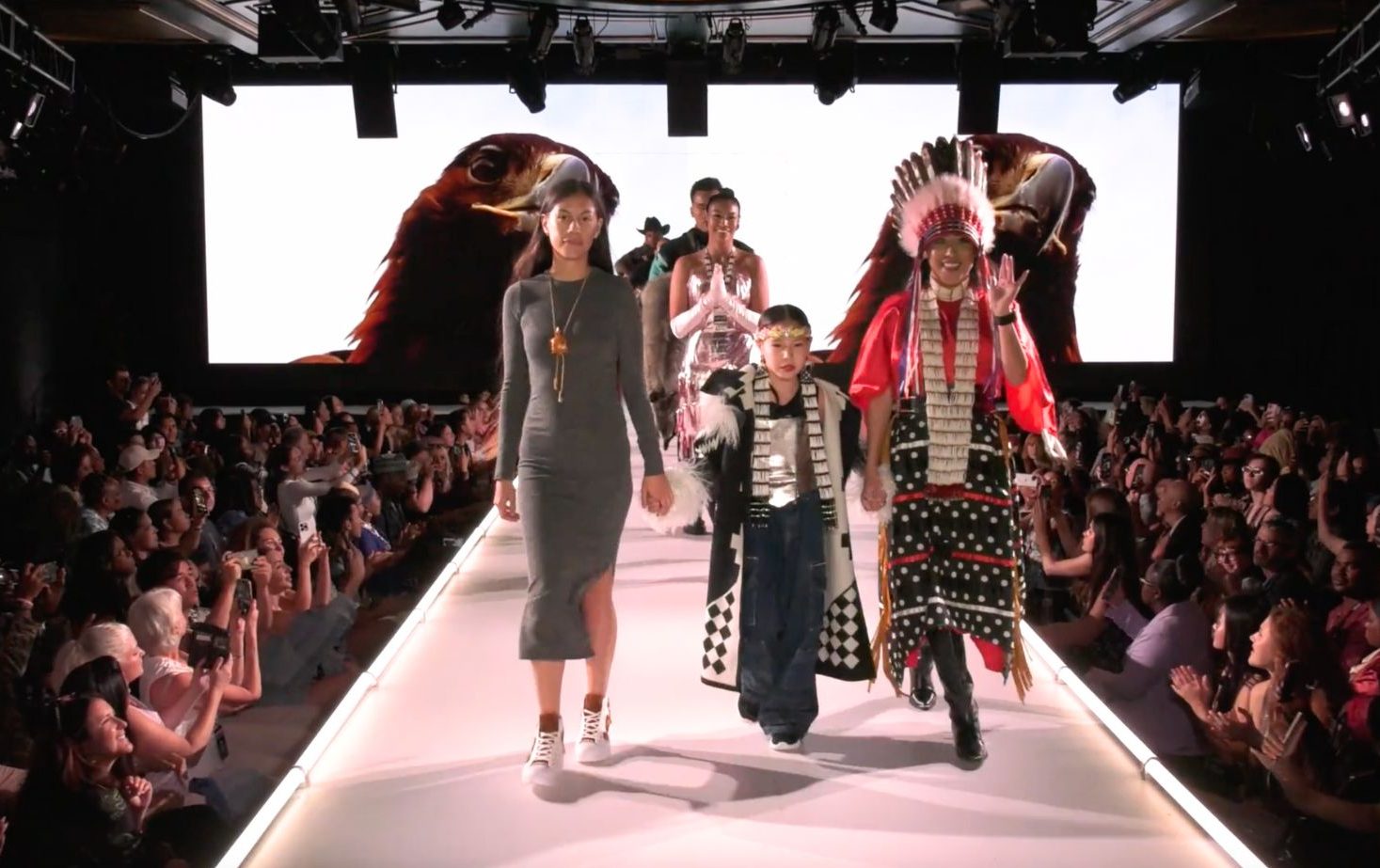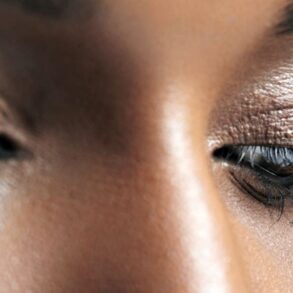C&I gets backstage and behind the scenes with Stephanie Crowchild to talk NY Fashion Week, her popular Pendleton coats, and what Barbie’s got to do with it.
C&I: Stephanie, it’s wonderful to see you again. It’s been well over a year and a half since our photo shoot in Texas at TR9 Ranch for C&I’s Fall Fashion. We were all racing around like maniacs with a cast of 10 influencers, and I didn’t get a chance to speak with you one-on-one. Tell me a little bit about yourself — let’s start with where you are from.
Stephanie Crowchild: Tsuu T’ina Nation, which is a Dene Nation in Treaty 7 area of Canada. In Canada there are 11 treaty territories, 1 to 11. Each province is within a different treaty. We’re in the 7 area, which is southern Alberta. Alberta is within Treaty 6, 7, and 8. I’m half Dene from Tsuu T’ina and half Cree from Saddle Lake, which is in Treaty 6.
C&I:It’s September 10th, here in New York City. It’s your second time showing in New York City. How did your design path in life begin?
Crowchild: I think I started my designing career when I was a kid. I think it all stemmed from my mom being a single mom. She left my dad when I was about 6. And I remember leaving Tsuu T’ina and [realizing] you don’t know you’re living in poverty. When the Barbie movie came out, it was kind of triggering because I would always ask my mom for Barbies and dollhouses and all of this stuff, but she could only give me so much. She ended up getting me a coloring book and pencil crayons and markers. I think that’s when I started.
C&I: Your coloring books and crayons turned out to be a great life lesson for kids and parents today — the gift of creating. What are your thoughts on that?
Crowchild: I used to just draw little people, my own Barbies, basically. And then I would design little paper clothes and put them on the dolls. I went to the extent of creating a little blueprint of a home on cardboard. I had to make do with what we had when I was a kid. I’m the oldest out of four sisters, seven siblings. I think it was that artistic vision as a kid and having that passion for art and fashion at that age and then getting into adolescence. When I was about 15, I started dancing powwow; I was dancing jingle. At powwows, usually everybody has beautiful regalia, but at night they would also have Pendleton coats. And I really wanted my own.
I kept begging my mom — I really want a Pendleton jacket. She’s like, “Well, they’re really expensive. I don’t think I can afford one at this time.” But she said, “We can get the blanket and we’ll get a pattern and me and your auntie will teach you.” I was about 16 when I made my first coat. I think I just visually memorized the structure, the garment construction of creating a coat at that age. I ended up having my daughter at 18 and then my other kids throughout my 20s. I threw my passion to the side to be a mom.
C&I: So from 18 to 30 years old, you put your design aspirations aside. You were very busy raising your family, and then the pandemic hits …
Crowchild: It wasn’t until the pandemic hit with COVID that I started sewing again. It just kind of started coming back to me. I was practicing on little fleece cotton and then felt brave enough to cut a Pendleton again. Come 2022, my friend Nikita had this woman’s group in Moose Cree [First Nation], which is a Cree reserve in Alberta, and she asked me if I could teach her women’s group how to make coats. I was really hesitant — impostor syndrome — and unsure of myself at the idea of being able to teach a class of 10. But I just motivated myself and did the first class in March of 2022, and then throughout the whole year, circling throughout the whole year, circling back today.
C&I: Not only are you designing and producing your own fashion line, but you are also on the road week in and week out teaching sewing classes to the elders.
Crowchild: Since March 2022, I’ve taught about 250 people how to make their own Pendleton coat. And that’s throughout treaties 1 to 11 — so throughout Canada. For 2024, I’ll be getting some more bookings into the U.S. I’ve been networking and meeting people. The lessons really consume. I’m already booking into next year for lessons. I like to do private ones with two, three, maybe five people. I think the biggest group I had was 40. Everybody wants a coat.
C&I: You flew straight from sewing lessons in Canada to showing in New York at one of the biggest fashion events globally — New York Fashion Week. That’s very impressive.
Crowchild: This is my second debut. My first debut was a 10-piece collection called Rise, which was September/fall for 2022. This collection, my second in New York, is a 20-piece collection and a lot more work.
C&I: Your show felt very personal. The opening video was emotional and thought-provoking. It brought tears to my eyes. I loved how you incorporated your daughter in the opening piece and then had her walk the runway. What was the inspiration behind the video?
Crowchild: The creative behind the video of the show was really stemming from A Tribe Called Red and Neon Natives and their remix of the song “Burn Your Village to the Ground.” I always felt like those lyrics resonated with me, like, ever since I was a kid when I first watched the Addams Family and Wednesday was talking about what it’s really like being Native. I felt my daughter would be the perfect one for that role of lip-syncing those words and incorporating it in our video. My vision was her lip-syncing to the Wednesday version but making it Indigenous.
All the recording of the video was actually filmed at our powwow celebrations back in the end of July. And we had three of our tepees set up. My daughter’s oldest brother was staying in one tepee, and he had his bustle, his traditional dancing bustle, hanging up in there. We used that for her to stand in front of. That’s what gave it that really captivating look of her with the eagle feathers behind her in the tepee.
When I saw the bustle hanging there, I just said, “That’s where you’ve got to stand. We’re going to get this shot. You’re going to lip-sync for your life.” We did, like, two takes. That was the first take, and she slayed it.
I thought it was perfect, and it was just kind of a goal, like a dream.
It was a hot day at the powwow. But I gave my vision to [my assistant] Thea. I said, “After Nadi’s done talking in the video, I want flames. Know the bass drops. I want flames, and I want just visuals of people dancing.” And then we incorporated each song. It’s like 15 minutes, right? And, yeah, she did all the recording that day. Yeah. She’s beautiful.
My vision of what I really wanted for my show was I wanted to captivate people and show them that we’re still here, we exist. And I think I did that.
Thea; and her boyfriend, Vince; and her cousin all collaborated together to get all the footage, all the recording of the dancers at our powwow. All the music was from A Tribe Called Red. It was just really amazing how it all came together. It was just kind of meant to be. Thank you.
C&I: You wore a beautiful headdress during your show. I never see you in traditional Native clothing. What inspired you to wear that?
Crowchild: The bonnet that I wore in the show actually came to me through a traditional ceremony called a Uepi, also known as a night lodge ceremony. The conductor of it, his name is Junior Fox and he’s from the Black Hills. And I had told him about my dream that I had a few months prior to receiving that headdress. But in my dream, I was being guided by two headdresses on each side of me. And it was kind of like the room was dark, and the only thing that had light on it was myself and a headdress to the right and a woman’s headdress to the left, which is known as a tall hat. And the men usually wear a long back bonnet, but those were guiding me in my dream, and I was talking to them and they were conversing back with me.
I just couldn’t see who was wearing them, but they were just floating on each side of me, guiding me in that direction. And so that was my indication that it was time for me to receive my own headdress through ceremony, through a transfer. And I chose to wear it in the show because that’s what guided me here to New York. That’s what’s been guiding me through my spirit. And I just felt like I had to wear that headdress to not only give recognition to the spirits in my dream that were guiding me, but also to know that everything I pray for, everything I sacrifice my life for, all of my piercings on my arms, those are all representation of my sacrifice to be where I am today.
And I feel like all of my prayers and my dreams have been manifested and it’s all becoming a reality, and I’m super-grateful for that. But that is the portion, the headdress. Thank you.
C&I: The headdress came to you in your dreams. What about your beautiful red dress. Is there symbolism behind the red dress?
Crowchild: What I wore during the show was a red tea dress that I made for Sundance. On the sides, I hung little mink tails, three of them on each side. And the black and white polka dot skirt is just one of my favorite skirts that I love, with the fringe hanging on the side. In the front, there’s a little thunderbird. That’s also one of my Sundance dresses. I felt like it was really significant for me to wear my ceremony clothing, because without ceremony, I honestly don’t know where I would be today. It’s helped me to regain my identity as a Dene Cree woman. And, yeah, I just felt super-proud out there, and I felt like I had to wear that to make my ancestors proud as well. Thank you.
C&I: What inspired you to incorporate such a diverse range of materials like fringe, leather, hide, and fur into your designs? And can you share your creative sources?
Crowchild: I incorporate a lot of fringe, pigskin, stone, leather, and a lot of hide and a lot of fur from an Indigenous trapper who’s been trapping since he was 8 years old. Babaski is his company’s name — the gentleman’s name’s Robert Grand Jam Jr. I actually met him through his mom when I was doing lessons in Fort Chip, which is a flying community in northern Alberta. That’s all they do — that’s their livelihood, hunting, fishing, trapping.
C&I: One of the pieces was actually the full skin. Was that a coyote?
Crowchild: It was a wolf. I had two wolves. I had the blue fox, and I had the purple dyed fox and another fox, and, yeah, just a lot of mainly fox and wolf.
C&I: What does the wolf symbolize to your culture?
Crowchild: I feel like it just symbolizes strength and resiliency. [Model] Andre Bear really wanted to wear the wolf, and he requested it, so I made it happen for him. He said that he felt strength and resiliency. My cousin Kehiw Eagletail-Frazier wore the pink pigskin.
C&I: You mentioned that one of the pieces was a legacy piece from your ancestors. Tell us about that.
Crowchild: That was the piece Tia was wearing. It was actually a fur coat, like a mink fur coat. That was my grandmother’s. She was a residential school survivor. In the U.S., people aren’t really familiar with Every Child Matters, which represents survivors of residential school. The color orange represents residential school survivors, like red represents Missing and Murdered Indigenous Women. That’s kind of the awareness colors for those.
C&I: One of the most impactful pieces in your show was the leather fringe jacket that was hand painted on the back with “Every Child Matters.” It had a children’s handprints on it.
Crowchild: Stemming from my grandmother [who was in a residential school], and then my parents, who met at a residential school, [it] runs in the family. The intergenerational trauma stemming from those schools is pretty detrimental. Sewing is what helps me with intergenerational healing so that I can be a good mom for my children.
C&I: I love seeing one of the models wear the I Heart New York shirt. It stuck out to me.
Crowchild: The I Heart New York shirt was renamed to I Heart Lenapehoking, which is the traditional territory of New York. The designer, Korina Emmerich, has a shop in New York. We went to her shop yesterday. I got to meet her. It was really nice. I incorporated the T shirt and also some of the jewelry. Her store is filled with Indigenous artists’ work, and her work’s really beautiful. I was unaware that [New York] was traditional territory of the Lenape people. They went through the same thing of being assimilated and moved from their traditional lands. What I like to do as an Indigenous person, is give a land acknowledgment of where I am to just have respect for their ancestors and their territories.
C&I: Who cast your show?
Crowchild: That was my picking — choosing of the models for the show was just very inclusive. For my model casting, about 80 percent of my models were Indigenous. It was a diverse group of people from all over, and the Indigenous models all traveled from Canada, Treaties 1 to 11. I wanted to really mix up the different treaty territories. We have some that are Cree, some that are Ojibwe and Anishinaabe, Mohawk. We have Dene and Northwest Territory. I’m so grateful for all the models that showed up. They were all so beautiful.
C&I: Hair plays a symbolic role in your culture. Tell me about the hair and makeup you chose for your show.
Crowchild: My hair and makeup team were actually my cousins from Alberta. My cousin Larissa Tail Feathers actually has her own salon in Calgary; her assistant, Jasmine Curry, [is also Indigenous]. They actually flew to Toronto and drove eight hours from Toronto to New York to be on time for the show. They were very dedicated. It was their first time attending New York Fashion Week, and they were super-grateful to have that experience. The concept for the hair and makeup, I just wanted some natural little bit of eyeliner and a lip to match the angora of the coat. I wanted to go with the long braid to just show like indigenous people usually have braids. So I went with long braids for most of the models, and some of them had their hair out. It was just beautiful. It was full representation of our hair and how our hair is actually connected to our spirits.
C&I: You’re from two different nationss. One is Cree, and the other is Dene. Tell us about those two different cultures and how your culture shaped who you are today.
Crowchild: Being half Cree from Saddle Lake, the language is more of plains Cree. The language is pretty hard, but my grandparents were all fluent speakers. The Dene language is the same dialect compared to the Navajos and Apache. So we’re all under the Dene dialect. Tsuut’ina is where we just randomly ended up. We’re the only Dene nation in Treaty 7. It’s mainly Blackfoot territory — and so we just kind of plotted ourselves there. And then Calgary surrounded our reserve, so we’re actually right across the road from Calgary.
C&I: Your 9-year-old daughter opened the show with such confidence. Her name is Naaditoshi. Where does that name come from?
Crowchild: My great-grandmother’s English name was Maggie, but her traditional name was Naaditoshi, which is my daughter’s name; it means “looking for something good after a battle.” My great-grandmother was also a tradeswoman. She had to learn Cree and she had to learn Blackfoot. Smart woman to speak those three tough languages. That’s pretty amazing when you don’t learn that in a classroom. She was learning it by word-of-mouth and sitting with the elders and learning it directly from them. She had to learn to be able to go and trade. We always had an Indigenous trading route throughout Turtle Island, and she was one of the tradeswomen. She would bring in food or goods.
C&I: I wonder what she would have made of Barbie. We started our conversation talking about how Barbie essentially led to your design career because you had to create your own doll and her clothes out of paper drawings. Did you ever own a Barbie?
Crowchild: I never owned a Barbie.
C&I: How did it make you feel to buy your daughter her first Barbie?
Crowchild: It was a moment of pride because Barbie has such a significance for young girls and even boys. When my daughter asked for one, I just said, “Yes, of course.” And, of course, I bought her, like, the biggest dollhouse. Well, it wasn’t the biggest, but it was big. It took us three hours to build.
C&I: Have you seen the movie? What do you think about the mainstream media reaction on the Barbie phenomenon today?
Crowchild: We didn’t see the movie. My reaction to [the Barbie phenomenon] is I think the color pink. That’s why I incorporated the pink in my show — because it just brings that significance. It’s the Barbie color, and it’s bright and empowering. But for my daughters, I think it’s giving them what they want and something I couldn’t have as a kid and being able to provide as a mother and spoil them.
C&I: Your Fashion Week is coming to a wrap, and you’re heading back to Canada — I should say Tsuut’ina. What are your goals over the next year? Are we going to see you back at New York Fashion Week in 2024?
Crowchild: I would like to. It was pretty intense. Thank goodness for my assistant. She’s like me, working this whole summer. I felt bad for my kids. They didn’t really have a summer because I was just plugging away and creating the pieces. I would have to really think if I wanted to do another show. It would be maybe more private or personal rather than going through an organization.
C&I: Maybe a space of your own, a studio that you invite people to, where it’s all about Stephanie Crowchild.
Crowchild: Yeah, that would be a goal.
You can find Stephanie Crowchild on Instagram.
This post was originally published on this site be sure to check out more of their content.



